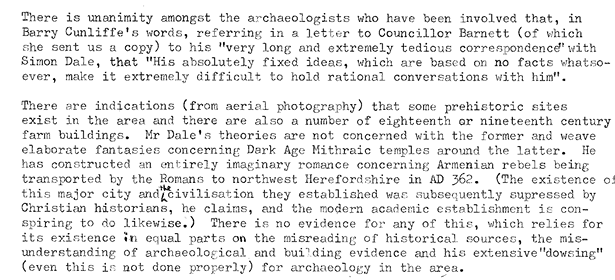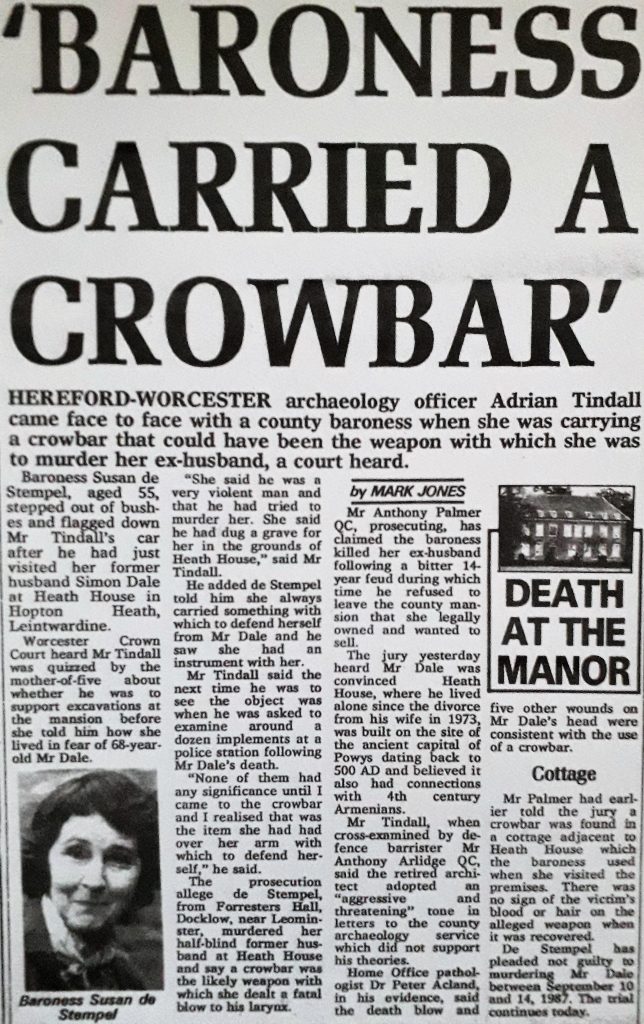It’s been a bumpy week for archaeologists. Who'd like a diverting tale? It concerns an architect, a Baroness, a derelict mansion, a county archaeologist, two murders, Barry Cunliffe, and a lost Armenian city on the Herefordshire/Shropshire border. Grab a glass, and settle in. 1/
I first came across this story in a stack of scanned letters relating to the history of Hereford and Worcester Archaeology Service (now @explorethepast). My old boss Simon Woodiwiss filled in the blanks. And for the background, I’m indebted to Terry Kirby’s 2007 investigation. 2/
Simon Dale was an architect, specialising in restoring country houses. In 1957 he married Susan Wilberforce (great-great granddaughter of William Wilberforce). In 1959 they bought Heath House, Clungunford: a derelict 17th century mansion on the Shropshire/Herefordshire border. 3/
They had 5 children, and poured all their money & energy into the children & the house. But in the late 1960s their relationship foundered. Simon was losing his sight, & with it, his ability to work. With the children away at boarding school, they began to live separate lives. 4/
A strange incident, unconnected to the family, took place in 1968: a GP was lured to a meeting at the top of the driveway by a man unhappy at his wife’s late cancer diagnosis. The unfortunate doctor was shot dead in his car. 5/
Simon and Susan divorced in 1972. She eventually settled with the children, in Docklow, near Leominster. Money was tight. At this point, a Latvian aristocrat — Baron Michael Victor Jossif de Stempel — re-entered her life. 6/
They had been in a relationship before her marriage to Simon, and remained in touch. Michael visited the family at Heath House. In the early 1980s, following Michael’s divorce from his 2nd wife, they got back together. They married in 1984: Susan became Baroness de Stempel. 7/
Simon and Susan’s 1972 divorce settlement had required Simon to sell the house and split the proceeds. But there was a catch. He wouldn't leave. 8/
He wouldn't leave because he had become convinced that the holy grail was buried nearby. 9/
He also believed that Armenian rebels had been banished there by the Romans in the late 4th century AD. They had established a city, now lost. 10/
They had set up Mithraic temples in the region, and a major post-Roman civilisation had prospered, in this far-flung corner of the Welsh Marches. 11/
(Obviously, the existence of all of this, Dale insisted, has been suppressed by Christian historians, to whom the academic establishment are in thrall.) 12/
He claimed to have discovered walls, streets, shops, houses, and temples. He gave interviews to newspapers. He enlisted the help of the county archaeology service... they dug trenches. He dug trenches. Many trenches. 13/
They found... nothing. He insisted that outbuildings were a match for the dimensions of a Roman temple. Archaeologists pointed out
a) they were mixed-date 18th/19th century vernacular buildings, and
b) some of them weren't on the 1848 tithe map, so couldn’t be ancient. 14/
a) they were mixed-date 18th/19th century vernacular buildings, and
b) some of them weren't on the 1848 tithe map, so couldn’t be ancient. 14/
[This is a nice example of how, once down a rabbit hole, facts are no match for beliefs. Simon was an architect, who specialised in historic buildings. On some level, he must have known that the 18th/19th century farm buildings could not be remnants of a 1500+ year-old city.] 15/
He found some iron-rich lumps that he claimed were slag from the city’s forges. They were tested, and found — as the archaeologists had told him they would be — to be naturally-occurring iron ore. 16/
The patience of County Archaeologist Jan Roberts was starting to wear thin, but Simon had the ear of an influential local Cllr, Olwyn Barnett. Politics came into play: the council was threatening to abolish the archaeology service. The archaeologists had to tread carefully. 17/
More importantly, Jan Roberts was acutely aware of local resentment surrounding the merger of Herefordshire and Worcestershire in 1974. Herefordshire got a raw deal, losing out to its larger neighbour. 18/
Power, money, funding and prestige were felt to be distributed unequally. Jan was keen to redress the balance, and he had investigated a Roman settlement at nearby Leintwardine. Roman remains in the area were not unlikely, and the area was undoubtedly under-researched. 19/
Unfortunately, Simon’s theories were groundless. But he persisted. He got Barry Cunliffe involved. Convinced that the locals were idiots, he got Cunliffe down to see the site. Cunliffe told him he was wrong. He told everyone else that he had Cunliffe's support. 20/
The saga rumbled on - he wouldn't sell the house because he thought it was a Mithraic temple on top of the Holy Grail. He was living in the kitchen, with no money, writing books about lost Armenian cities. Relying on kindly neighbours who would darn his only jumper for him. 22/
By now, Simon was almost completely blind. The broke Baroness was occasionally returning to take the furniture, and try to smarten the place up for a sale that would never take place. With Michael’s help, she had also begun defrauding an elderly relative, Lady Illingworth. 23/
And in the meantime, Jan Roberts had gone. He had managed to save the archaeology service, but he’d stood up to local politicians one too many times, and paid for it with his job. 24/
A new County Archaeologist — Adrian Tindall — arrived to take up the post. Fresh blood. Simon Dale eventually persuaded him to come out for a site visit. 25/
So the County Archaeologist turns up, presumably knowing the background, but equally mindful of the need to ensure that the archaeologically under-represented border areas of Herefordshire/Shropshire got the focus they deserved. 26/
Strap in, this is where it gets a bit weird...
He visited Simon Dale, one Friday in September 1987. After the meeting, as he drove back through the grounds, the Baroness jumped out of the bushes carrying a crowbar. She flagged down his car. 27/
He visited Simon Dale, one Friday in September 1987. After the meeting, as he drove back through the grounds, the Baroness jumped out of the bushes carrying a crowbar. She flagged down his car. 27/
Somewhat incongruously, crowbar over her shoulder, she asked him if he was going to support carrying out some archaeological excavations. 28/
Then she told him that Simon had dug a grave for her in the garden, and she needed to carry a weapon for protection. 29/
He drove home, and presumably vowed never to go anywhere near the place again. 30/
A few days later, Simon Dale's editorial assistant walked in to find Dale dead on the floor from a hefty blow to the larynx. Food was still cooking in the oven, but he'd evidently been dead for some time. 31/
The last person to see him alive? Adrian, the County Archaeologist. 32/
The County Archaeologist was called into the police station, and shown an array of objects recovered from the grounds. 33/
He recognised the crowbar - it was the one the baroness was carrying, found in the cottage in the grounds that she habitually stayed in while liberating the furniture.
It was examined.
It had recently been thoroughly cleaned. 34/
It was examined.
It had recently been thoroughly cleaned. 34/
Here's an excerpt from an article by Terry Kirby in the Independent (2007), with an account of the trial:
Susan treated the police with contempt… "You would have been proud of me," she wrote to Michael… 36/
Susan treated the police with contempt… "You would have been proud of me," she wrote to Michael… 36/
"if you had heard the lectures I gave all those little men about the ancient nobility of your family and mine." The little men, in turn, were astounded at the lack of emotional response when they broke the news of Dale's death to those at Docklow… 37/
...The highlight of the trial was her performance during a two-day-long interrogation by Anthony Palmer QC, one of the country's best inquisitors, who was treated like a dim retainer for even suggesting her mounting anger with Dale had turned into violence… 38/
..."I wish you would get into your head, Mr Palmer," she announced loftily, "that I was not angry with Simon." Another accusation was dismissed with: "Bollocks, Mr Palmer!"... 39/
...Ian Bullock, the detective superintendent in charge of the murder inquiry, remembers her disarming composure: "At the end of a long day in the witness box, it was she who looked down at me and said, 'You do look tired, Mr Bullock' ."... 40/
...Most observers felt she had won on points – the jury clearly agreed....
She was acquitted. 41/
She was acquitted. 41/
No-one else has ever been charged. The case remains one of West Mercia police force's few unsolved murders. The lack of physical evidence proved the prosecution's undoing. 42/
But the story doesn't end there. In the course of the police investigations, they uncovered evidence of the defrauding of Lady Illingworth, and her lonely end in a Hereford care home. Along with Michael and two of her children, Susan was convicted of fraud, and jailed. 43/
There's also the unanswered mystery about the whereabouts of £12 million in gold bars...
But that's for another thread. If this strange tale has piqued your interest, Terry Kirby’s brilliant investigation can be read here: https://web.archive.org/web/20070915034238/http://news.independent.co.uk/uk/crime/article2820965.ece 44/
But that's for another thread. If this strange tale has piqued your interest, Terry Kirby’s brilliant investigation can be read here: https://web.archive.org/web/20070915034238/http://news.independent.co.uk/uk/crime/article2820965.ece 44/
And here are accounts of Jan Roberts’ ( https://www.explorethepast.co.uk/2019/10/archaeology-50-jan-roberts-1975-86/)
and Adrian Tindall’s ( https://www.explorethepast.co.uk/2019/10/archaeology-50-adrian-tindall/)
time as County Archaeologists for Hereford and Worcester. 45/
and Adrian Tindall’s ( https://www.explorethepast.co.uk/2019/10/archaeology-50-adrian-tindall/)
time as County Archaeologists for Hereford and Worcester. 45/
The 8th person to hold the post (for Worcestershire: Herefordshire now has its own excellent team of archaeologists) has recently been appointed. It is my former boss Emma Hancox ( @HancoxEm). A fine archaeologist, and worthy successor. I wish her a less eventful time. 46/
Thank you for listening.
Remember, next time someone claims to have found the Holy Grail in their garden, maybe pass up the opportunity for a site visit, unless you want to be mixed up in a murder trial.
END/.
Remember, next time someone claims to have found the Holy Grail in their garden, maybe pass up the opportunity for a site visit, unless you want to be mixed up in a murder trial.
END/.

 Read on Twitter
Read on Twitter



